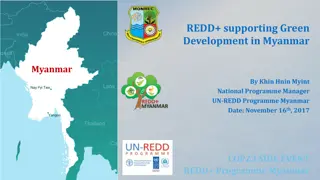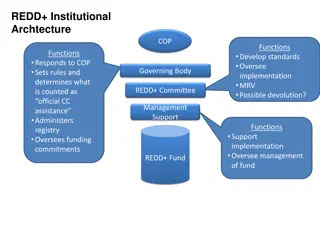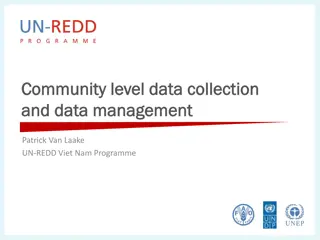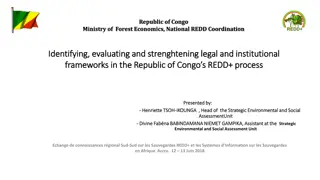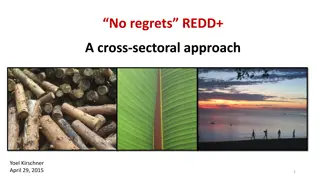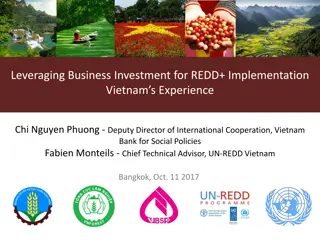Framework for Building National Forest Monitoring Systems for REDD+
This module outlines a comprehensive framework for developing national forest monitoring systems for REDD+ initiatives. It covers key components such as satellite land monitoring, national forest inventories, greenhouse gas reporting, emission factors, and integrated monitoring systems focusing on carbon, safeguards, and co-benefits. The module emphasizes the importance of governance, economic distribution, environmental aspects, and sociocultural dimensions in establishing an effective REDD+ monitoring system. Capacity building activities are also highlighted to enhance institutional and technical expertise in monitoring and reporting on forest resources.
Download Presentation

Please find below an Image/Link to download the presentation.
The content on the website is provided AS IS for your information and personal use only. It may not be sold, licensed, or shared on other websites without obtaining consent from the author. Download presentation by click this link. If you encounter any issues during the download, it is possible that the publisher has removed the file from their server.
E N D
Presentation Transcript
Module 1.2 Framework for building national forest monitoring systems for REDD+ Module developers: Erika Romijn, Wageningen University Martin Herold, Wageningen University Brice Mora, Wageningen University Country examples: 1. UN-REDD monitoring framework for the Democratic Republic of Congo 2. Establishment of a system for monitoring, reporting, and verification (MRV) of REDD+ in Guyana V1, May 2015 1 Module 1.2 Framework for building national forest monitoring systems for REDD+ REDD+ training materials by GOFC-GOLD, Wageningen University, World Bank FCPF Creative Commons License
1. UN-REDD monitoring framework for the Democratic Republic of Congo (DRC) Main components of national forest monitoring system IPCC elements DRC MRV system elements 1 Activity data Satellite Land Monitoring System (SLMS): for measurement of changes in forest area using remote sensing (the M of MRV) National forest inventory (NFI): A system for measuring carbon on the ground in the different primary and secondary forest ecosystems (the M of MRV) National GHGs inventory: Reporting through the national greenhouse gas (GHG) inventory of the DRC (the R of MRV) 2 Emission factors 3 Emission estimates 2 Module 1.2 Framework for building national forest monitoring systems for REDD+ REDD+ training materials by GOFC-GOLD, Wageningen University, World Bank FCPF
Integrated monitoring system Monitoring carbon Monitoring safeguards and co-benefits: Governance: transparent and accountable and involves participation of local communities Economic aspects: distribution of costs and benefits for REDD+ Environmental aspects: forest functions and services, such as water quality, nontimber forest products, and biodiversity Sociocultural dimensions Integrated MRV system using a participatory approach 3 Module 1.2 Framework for building national forest monitoring systems for REDD+ REDD+ training materials by GOFC-GOLD, Wageningen University, World Bank FCPF
Capacity building activities Institutional and technical capacity building National expertise forms the starting point Integration of existing capacities, expertise and different institutes Technical training by international experts on: International requirements from UNFCCC and IPCC Reporting of GHG emissions and removals Implementing the SLMS: use of remote sensing and GIS Implementing the NFI: taking field measurements Data management 4 Module 1.2 Framework for building national forest monitoring systems for REDD+ REDD+ training materials by GOFC-GOLD, Wageningen University, World Bank FCPF
2. Establishment of a system for monitoring, reporting, and verification of REDD+ in Guyana Requirements for national MRV system: International: principles and procedures specified by the IPCC (2003, 2006) Good Practice Guidance and Guidelines National: needs and priorities of the national REDD policy and implementation strategy Bridging the capacity gap: Assessment: of existing national forest monitoring technical capabilities versus the requirements for the MRV system Develop a roadmap: to build sustained in-country capacities for MRV 5 Module 1.2 Framework for building national forest monitoring systems for REDD+ REDD+ training materials by GOFC-GOLD, Wageningen University, World Bank FCPF
Capacity gap assessment for Guyana Variable Focus Existing observations Existing information Deforestation maps/rates National statistical data Land-use change maps Archived satellite data airphotos Forest maps and field data Maps of forest use and human infrastructures Area changes (activity data) Deforestation Area affected by degradation and rates Degradation Forest inventory, permanent sample plots, research sites, in- situ measurements Forest/ecosystem stratifications Forest concessions/harvests Volume to carbon conversions Regional carbon stock data/maps Records of fire events Satellite data Emission factor measurements Topographic maps Field surveys Land-use change (deforestation) Carbon stock change and emission/ha estimates Changes in carbon stocks / emission factors Long-term C-reduction measurements Degradation Long-term measurements of soil carbon changes Other pools (i.e., soils) Satellite data products Fire regime, area, frequency, and emissions GIS-datasets on population, roads, land use, planning, Biomass burning Emissions of several GHGs 6 Module 1.2 Framework for building national forest monitoring systems for REDD+ REDD+ training materials by GOFC-GOLD, Wageningen University, World Bank FCPF (spatial) factors of forest Census data Ancillary Drivers and
Analysis of drivers of deforestation and processes affecting forest carbon stocks 1. Forest land conversion for agriculture (livestock, crops, and aquaculture) 2. Forest land conversion for mining 3. Logging activities 4. Forest land conversion for roads 5. Forest land conversion for urban development (housing) 6. Forest land conversion for local agricultural economies in transition 7. Forest land conversion for energy development 8. Fires (fires for sustainable use are not included) 9. Issues of subsistence farming (including fire) 10.Forest protection 11.Mangrove improvement for sea defence purposes (agricultural fires and accidental burning of forest) 7 Module 1.2 Framework for building national forest monitoring systems for REDD+ REDD+ training materials by GOFC-GOLD, Wageningen University, World Bank FCPF
Analysis of drivers of deforestation and processes affecting forest carbon stocks Responsible group / institution for the execution of the activity Effects on the forest (carbon effect per ha): sink or source Size of the area affected Importance with respect to carbon impact and area 8 Module 1.2 Framework for building national forest monitoring systems for REDD+ REDD+ training materials by GOFC-GOLD, Wageningen University, World Bank FCPF
Key action areas for capacity-building activities 1. Develop and implement a national mechanism and institutional framework 2. Conduct a comprehensive forest area change assessment for a historical period 3. Build carbon stock measurement capacities 4. Develop MRV for a set of REDD demonstration activities, with the focus on key drivers / processes 5. Engage with international community 6. Sustain internal communication mechanism on MRV 7. Conduct / support research on key issues 9 Module 1.2 Framework for building national forest monitoring systems for REDD+ REDD+ training materials by GOFC-GOLD, Wageningen University, World Bank FCPF
Capacity-building objectives for the different REDD+ implementation phases REDD+ implementation phase Phase 1: National strategy Objectives Gather and integrate information and fill data gaps for national REDD+ opportunities, scoping, and policy development Develop capacities, conduct historical monitoring, and implement a (minimum) IPCC Tier 2 national forest carbon monitoring, establish the reference level, and report on interim performance Establish consistent and continuous MRV supporting national REDD+ actions and international IPCC GPG-based reporting and verification Phase 2: Country readiness Phase 3: Implementation 10 Module 1.2 Framework for building national forest monitoring systems for REDD+ REDD+ training materials by GOFC-GOLD, Wageningen University, World Bank FCPF
Development of institutional framework A steering body coordinating all REDD+ MRV activities and the implementation of the roadmap The Guyana Forestry Commission as executive agency A process for involving all relevant national stakeholders involved in MRV and REDD+ implementation and mechanisms to ensure transparent and open exchange and management of data Partnership building and cooperation with key national and international organizations that help Guyana in implementing the road map 11 Module 1.2 Framework for building national forest monitoring systems for REDD+ REDD+ training materials by GOFC-GOLD, Wageningen University, World Bank FCPF
Recommended modules as follow-up Module 1.3 for considering national circumstances within a national forest monitoring system and assessing and analyzing drivers of deforestation and forest degradation Modules 2.1 to 2.8 to continue with REDD+ measuring and monitoring Modules 3.1 to 3.3 to learn more about REDD+ assessment and reporting 12 Module 1.2 Framework for building national forest monitoring systems for REDD+ REDD+ training materials by GOFC-GOLD, Wageningen University, World Bank FCPF
References Bholanath, P., N. Dewnath, and J. Singh. 2012. Developing a Monitoring, Reporting and Verification System for REDD+ in Guyana. In Capacity Development in National Forest Monitoring: Experiences and Progress for REDD+, edited by B. Mora, M. Herold, V. De Sy, A. Wijaya, L. Verchot, and J. Penman, 5 18. Bogor, Indonesia: Center for International Forestry Research. http://www.cifor.org/online- library/browse/view-publication/publication/3944.html. DRC (Democratic Republic of Congo). 2010. Readiness Plan for REDD, 2010 2012: R-PP Final Version. Kinshasa: Ministry of Environment. https://www.forestcarbonpartnership.org/sites/forestcarbonpartnership.org/files/Documents/PDF/Jul201 0/R-PP_V3.1_English_July2010.pdf Guyana Forestry Commission. 2009. Terms of Reference for Developing Capacities for a National Monitoring, Reporting and Verification System to Support REDD+ Participation of Guyana. Netherlands and Georgetown, Guyana: Wageningen University, Centre for Geoinformation and Guyana Forestry Commission. http://www.forestry.gov.gy/Downloads/Terms_of_Reference_for_Guyana s_MRVS_Final.pdf 13 Module 1.2 Framework for building national forest monitoring systems for REDD+ REDD+ training materials by GOFC-GOLD, Wageningen University, World Bank FCPF
Herold, M., and P. Bholanath. 2009. Preparing Guyana s REDD+ Participation: Developing Capacities for Monitoring, Reporting and Verification. Report and Summary of a Workshop and Consultation Held 27 29 October 2009 in Georgetown, Guyana. Prepared for the Government of Norway. http://www.forestry.gov.gy/Downloads/Guyana_MRV_workshop_report_Nov09.pdf. IPCC, 2003. 2003 Good Practice Guidance for Land Use, Land-Use Change and Forestry, Prepared by the National Greenhouse Gas Inventories Programme, Penman, J., Gytarsky, M., Hiraishi, T., Krug, T., Kruger, D., Pipatti, R., Buendia, L., Miwa, K., Ngara, T., Tanabe, K., Wagner, F. (eds.). Published: IGES, Japan. http://www.ipcc-nggip.iges.or.jp/public/gpglulucf/gpglulucf.html (Often referred to as IPCC GPG) IPCC 2006. 2006 IPCC Guidelines for National Greenhouse Gas Inventories, Prepared by the National Greenhouse Gas Inventories Programme, Eggleston H.S., Buendia L., Miwa K., Ngara T. and Tanabe K. (eds). Published: IGES, Japan. http://www.ipcc-nggip.iges.or.jp/public/2006gl/vol4.html (Often referred to as IPCC AFOLU GL) 14 Module 1.2 Framework for building national forest monitoring systems for REDD+ REDD+ training materials by GOFC-GOLD, Wageningen University, World Bank FCPF





